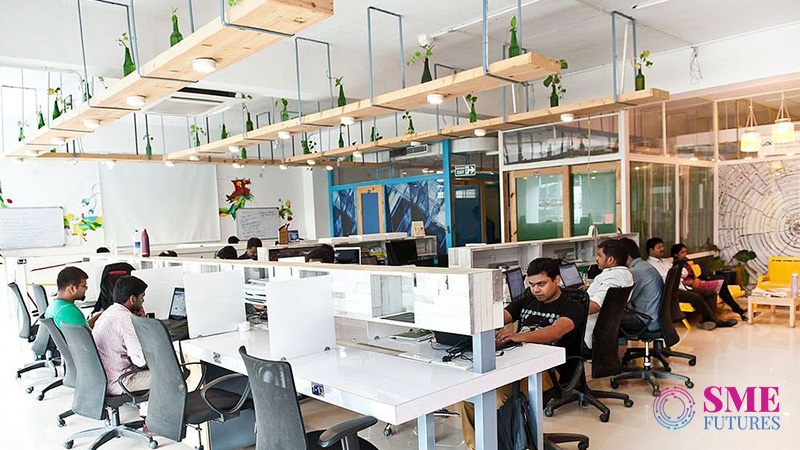Just when co-working spaces started flourishing in India, the pandemic spelled doom for them. In the past three years, the dominance of “remote work” and “work from home” had dimmed the prospects of co-working spaces.
But there is always a silver lining. Hybrid work culture has come to the fore now, breathing new life into the co-working landscape.
Hybrid work culture has surged following the pandemic. In fact, globally, hybrid work increased by 29 per cent (year on year) between April and June. The ability to contribute from anywhere has changed the game for Indian co-working spaces, leading to their exponential expansion.
“The demand for co-working spaces weakened considerably during the pandemic. It disrupted workplace equations across the country. But now, we’re seeing a decisive reversal of this negative trend, with co-working becoming particularly attractive because of the disrupted IT/ITeS employment scenario,” says Utkarsh Kawatra, Senior Director-myHQ (Anarock Group)
According to Anarock, in the January-March period of Q1 2023, co-working spaces accounted for about 27 per cent of net absorption in office real estate, a remarkable leap from the 14 per cent recorded in Q1 2019.
Metro cities are top adopters
Leading the charge in this revitalisation are the metro cities, especially those in the IT/ITeS sectors, which are increasingly favouring the flexibility offered by co-working spaces. The attractiveness of these spaces is rooted in their diverse locations – spanning residential areas, malls, and hotels – as well as their cost-effectiveness compared to traditional offices with prolonged lock-in periods.
Cities like Bengaluru, Chennai, Pune, and the Delhi-NCR region are witnessing a surge in demand for co-working spaces, fuelled by low vacancy levels in Grade A offices, particularly in IT/ITeS-driven hubs.
Bengaluru and Delhi-NCR jointly account for a significant 66 per cent of net co-working absorption in Q1 2023. Over the same period, Pune and Chennai absorbed around 0.52 million square feet of co-working space. This trend is highlighted by a remarkable 90 percent increase in net absorption of co-working spaces across the top seven cities, rising from 1.3 million square feet in Q1 2019 to nearly 2.18 million square feet in Q1 2023.

Hybrid work driving the revival
Crucially, it’s the paradigm shift to hybrid work that has ignited this resurgence. As Indian businesses transition from the “work from home” norm to crafting hybrid work models, they are re-evaluating their real estate footprints.
“This shift is a key driver behind the increasing demand for co-working spaces,” says Umesh Uttamchandani, Co-Founder, DevX, a co-working office space player.
“The transition is prompting companies to relinquish their conventional office assets, which they once held as direct liabilities, in favour of flexible spaces provided by co-working entities like us,” he adds.
According to Uttamchandani, even if it appears like enterprises are transferring their bases to co-working spaces on a temporary basis, it is not a passing fad.
“Even here, they are committing to four or five years. The tenure is longer, but it costs less when compared to the assets that they would have taken prior to COVID-19. So, it is this evaluation that gives this industry a push or momentum,” he says.
DevX is the largest co-working space provider in Gujarat, and it has recently launched its 4th 1,80,000 sq feet co-working space in Ahmedabad with 3000 seats, as it is witnessing remarkable demand.
Dr. Ankur Sharma, Founder of Aartas CliniShare, a co-working space tailored for doctors says that multiple factors underpin this paradigm shift. “It includes rental costs, lack of infrastructure, and the realisation that effective cooperation may occur in both physical and virtual contexts,” he says.
Trends in co-working sector
The co-working sector is being shaped by a series of notable trends.
First and foremost, co-working providers are moving towards customisation and specialisation. For example, take Aartas Clinishare, which caters to medical professionals.
“Tailoring the surroundings according to certain businesses or communities, such as tech start-ups, the creative professions, or even medical professionals, builds togetherness and generates a sense of shared purpose. Like the rise of mixed work cultures is forcing businesses to reconsider their real estate footprints, doctors too are in search for efficient spaces that will help them to build their independent brands and practices,” says Sharma.
Sharma’s co-working space has been offering prime seats in South Delhi location since August 2021. “The response generated in the last 12-18 months has been tremendous. We have 38 specialists using the centre, and we are expanding to Gurugram from the 1st of September. Also, we are already in talks for 3 more CliniShare’s (2 in NCR & 1 in Mumbai) in the coming months,” he adds.
Co-working spaces are adopting flexible arrangements. A variety of solutions, ranging from hourly bookings to dedicated workstations and private offices, are available to accommodate a wide range of work styles and budgets.
Furthermore, to suit the digital expectations of today’s professionals, these spaces are rapidly embracing innovative technologies. They now include high-speed internet, smart workplace facilities, and user-friendly booking systems.
These trends highlight the co-working sector’s dynamic evolution, making it a key player in the ever-changing work landscape.

Going beyond metros
It’s worth noting that the expansion of co-working spaces is not limited to metro cities alone. Tier 2 cities like Ahmedabad, Indore, Raipur, and Jaipur are witnessing a flourishing of co-working spaces.
“It is primarily due to businesses providing work close to home. So, instead of relocating for work, the talent pool would rather stay in their area and work from co-working facilities. As a result, businesses are catching on to the pattern,” says Uttamchandani.
Also, tier 2 cities are seeing a significant increase in IT infrastructure and consumption. This has increased office demand, but these cities were never prepared to consume the demand that we are now witnessing.
“Also, because these cities currently lack global or national players, we are mostly targeting tier 2 cities,” he elaborates.
The past few months have seen unprecedented market growth. With the surge in start-ups, demand has exceeded expectations in both major cities and in tier 2 towns. According to Uttamchandani, the sector’s growth is expected to mirror 15 to 16 per cent of India’s overall leasing activity. Its trajectory is pointing upwards, with projections indicating growth rates of 35 to 40 per cent in the next three years, he says.
The co-working sector’s revival is fuelled by the rise of hybrid work models and the flexibility that they demand. This resurgence has sparked a transformation within the sector, marked by trends like customisation, specialisation, flexible arrangements, and technology integration. The exponential growth of co-working spaces points to a bright future for the co-working sector as it continues to evolve in tandem with the ever-changing work landscape.











